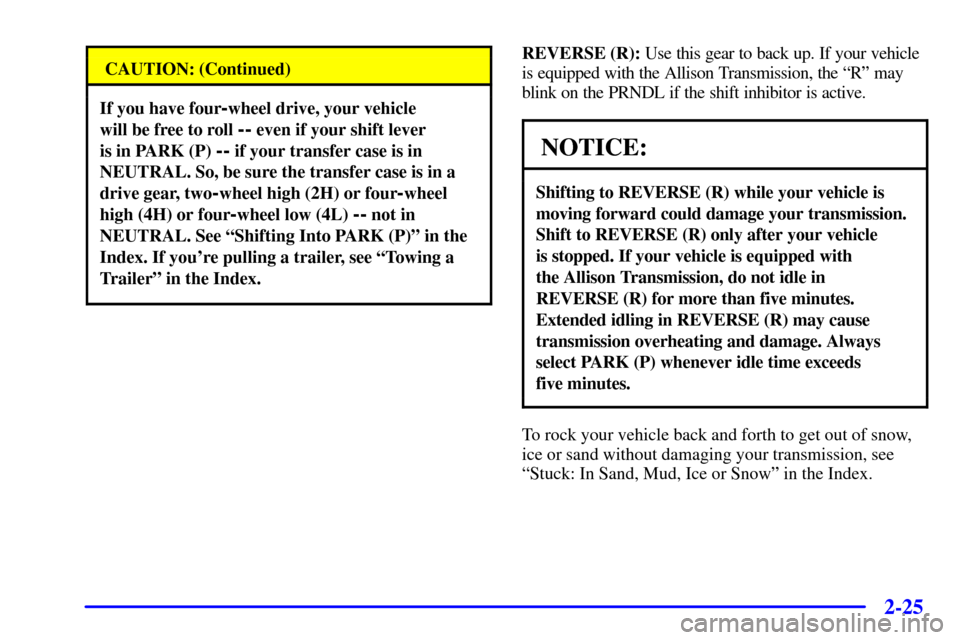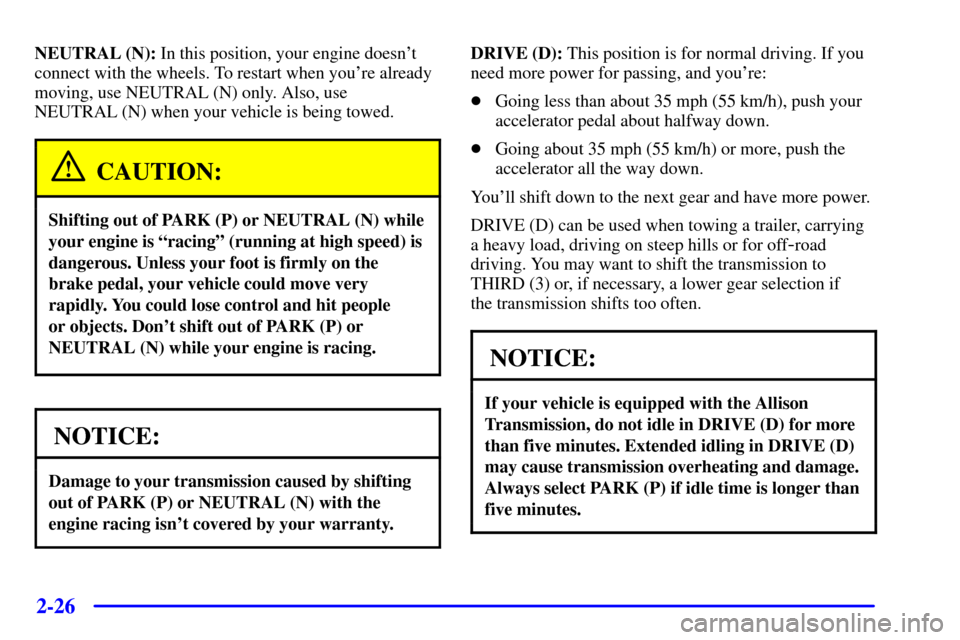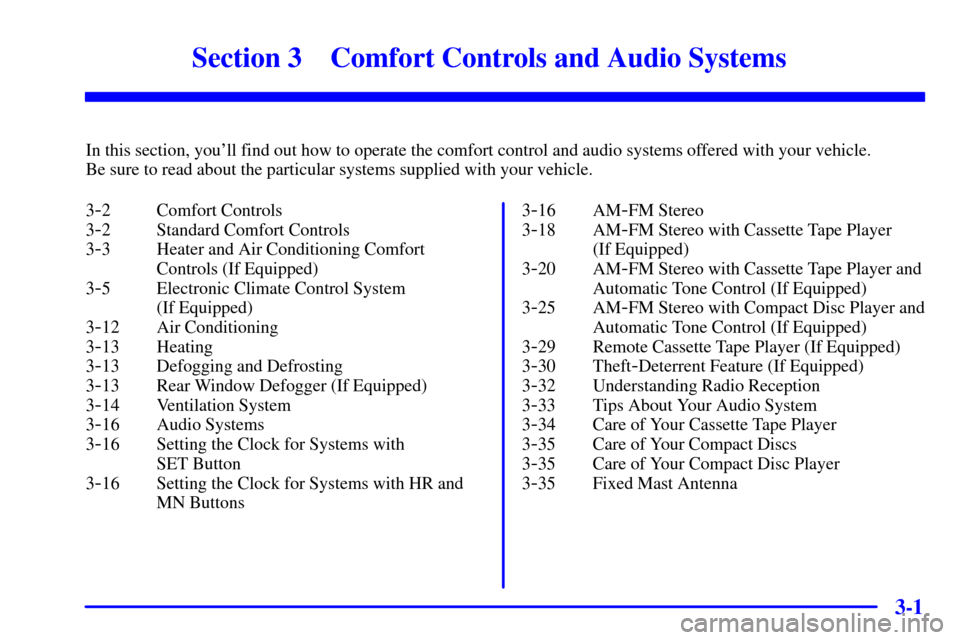Page 5 of 468
iii
Section
3
Comfort Controls and Audio Systems
Section
4
Your Driving and the Road
Section
5
Table of Contents (cont'd)
Your Driving, the Road and Your Vehicle
Defensive Driving
Drunken Driving
Control of a Vehicle
Braking
SteeringDriving Tips for Various Road Conditions
Off-Road Driving
Recreational Vehicle Towing
Loading Your Vehicle
Towing a Trailer Heating and Air Conditioning
Setting the Radio ClockRadio/Cassette Player/CD Player
Radio Theft-Deterrent Feature (If Equipped)
Hazard Warning Flashers
Jump Starting
Towing Your VehicleEngine Overheating
Changing a Flat Tire
If You're Stuck
Problems on the Road
Page 108 of 468

2-25
CAUTION: (Continued)
If you have four-wheel drive, your vehicle
will be free to roll
-- even if your shift lever
is in PARK (P)
-- if your transfer case is in
NEUTRAL. So, be sure the transfer case is in a
drive gear, two
-wheel high (2H) or four-wheel
high (4H) or four
-wheel low (4L) -- not in
NEUTRAL. See ªShifting Into PARK (P)º in the
Index. If you're pulling a trailer, see ªTowing a
Trailerº in the Index.
REVERSE (R): Use this gear to back up. If your vehicle
is equipped with the Allison Transmission, the ªRº may
blink on the PRNDL if the shift inhibitor is active.
NOTICE:
Shifting to REVERSE (R) while your vehicle is
moving forward could damage your transmission.
Shift to REVERSE (R) only after your vehicle
is stopped. If your vehicle is equipped with
the Allison Transmission, do not idle in
REVERSE (R) for more than five minutes.
Extended idling in REVERSE (R) may cause
transmission overheating and damage. Always
select PARK (P) whenever idle time exceeds
five minutes.
To rock your vehicle back and forth to get out of snow,
ice or sand without damaging your transmission, see
ªStuck: In Sand, Mud, Ice or Snowº in the Index.
Page 109 of 468

2-26
NEUTRAL (N): In this position, your engine doesn't
connect with the wheels. To restart when you're already
moving, use NEUTRAL (N) only. Also, use
NEUTRAL (N) when your vehicle is being towed.
CAUTION:
Shifting out of PARK (P) or NEUTRAL (N) while
your engine is ªracingº (running at high speed) is
dangerous. Unless your foot is firmly on the
brake pedal, your vehicle could move very
rapidly. You could lose control and hit people
or objects. Don't shift out of PARK (P) or
NEUTRAL (N) while your engine is racing.
NOTICE:
Damage to your transmission caused by shifting
out of PARK (P) or NEUTRAL (N) with the
engine racing isn't covered by your warranty.
DRIVE (D): This position is for normal driving. If you
need more power for passing, and you're:
�Going less than about 35 mph (55 km/h), push your
accelerator pedal about halfway down.
�Going about 35 mph (55 km/h) or more, push the
accelerator all the way down.
You'll shift down to the next gear and have more power.
DRIVE (D) can be used when towing a trailer, carrying
a heavy load, driving on steep hills or for off
-road
driving. You may want to shift the transmission to
THIRD (3) or, if necessary, a lower gear selection if
the transmission shifts too often.
NOTICE:
If your vehicle is equipped with the Allison
Transmission, do not idle in DRIVE (D) for more
than five minutes. Extended idling in DRIVE (D)
may cause transmission overheating and damage.
Always select PARK (P) if idle time is longer than
five minutes.
Page 158 of 468

2-75
Ashtrays and Cigarette Lighter
Front Ashtray
The front ashtray is located near the center of the
instrument panel. Pull on the bottom of the ashtray door
to open it.
NOTICE:
If you store paper or other things that burn in
your ashtrays, they could be set on fire by
cigarettes or other smoking materials. That could
cause a fire and possibly damage your vehicle.
Do not store papers and other things that burn in
your ashtrays.
To remove the front ashtray, press the retainer spring
and pull the ashtray toward you. To replace the ashtray,
place the ashtray on the slides at the side of its location
in the instrument panel. Then slide the ashtray back to
its original position.
To use the cigarette lighter, push it in all the way, and let
go. When it's ready, it will pop back out by itself.
NOTICE:
Holding a cigarette lighter in with your hand
while it's heating can make it overload, damaging
the lighter and the heating element. Just push the
lighter all the way in and let go. When it's done,
it will pop back by itself.
Page 173 of 468
2-90
Engine Coolant Temperature Gage
United States Canada
This gage shows the engine coolant temperature.
It also provides an indicator of how hard your vehicle is
working. During a majority of the operation, the gage
will read 210�F (100�C) or less. If you are pulling a
load or going up hills, it is normal for the temperature to
fluctuate and approach the 250�F (122�C) mark. If the
gage reaches the 260�F (125�C) mark, it indicates that
the cooling system is working beyond its capacity.
See ªEngine Overheatingº in the Index.
Transmission Temperature Gage
(If Equipped)
United States Canada
Your vehicle may be equipped with a transmission
temperature gage.
When your ignition is on, the gage shows the temperature
of the transmission fluid. The normal operating range is
from 100�F (38�C) to about 265�F (130�C).
Page 185 of 468

2-102
Low Coolant
This message is displayed
when the cooling system is
low on coolant.
The engine may overheat. See ªEngine Coolantº in the
Index and have your vehicle serviced as soon as you can.
Check Coolant Temp
This message is displayed
when the cooling system
temperature gets hot.
Check the coolant temperature gage and the coolant
level. See ªEngine Coolantº and ªEngine Coolant
Temperature Gageº in the Index. See ªEngine
Overheatingº in the Index for further information.
Engine Overheated
This message is displayed
when the cooling system
temperature gets too hot.
This message will be displayed after the air conditioning
system has automatically turned off for the engine
coolant protection mode. See ªEngine Overheatingº in
the Index for further information.
Reduced Engine Power
(V8 Gasoline Engines Only)
This message is displayed
when the cooling system
temperature gets too hot and
the engine further enters
the engine coolant
protection mode.
If your vehicle is equipped with the 8.1L engine, this
light may come on because of an electronic throttle
control system fault. See ªEngine Overheatingº in
the Index for further information.
Page 188 of 468

3-
3-1
Section 3 Comfort Controls and Audio Systems
In this section, you'll find out how to operate the comfort control and audio systems offered with your vehicle.
Be sure to read about the particular systems supplied with your vehicle.
3
-2 Comfort Controls
3
-2 Standard Comfort Controls
3
-3 Heater and Air Conditioning Comfort
Controls (If Equipped)
3
-5 Electronic Climate Control System
(If Equipped)
3
-12 Air Conditioning
3
-13 Heating
3
-13 Defogging and Defrosting
3
-13 Rear Window Defogger (If Equipped)
3
-14 Ventilation System
3
-16 Audio Systems
3
-16 Setting the Clock for Systems with
SET Button
3
-16 Setting the Clock for Systems with HR and
MN Buttons3
-16 AM-FM Stereo
3
-18 AM-FM Stereo with Cassette Tape Player
(If Equipped)
3
-20 AM-FM Stereo with Cassette Tape Player and
Automatic Tone Control (If Equipped)
3
-25 AM-FM Stereo with Compact Disc Player and
Automatic Tone Control (If Equipped)
3
-29 Remote Cassette Tape Player (If Equipped)
3
-30 Theft-Deterrent Feature (If Equipped)
3
-32 Understanding Radio Reception
3
-33 Tips About Your Audio System
3
-34 Care of Your Cassette Tape Player
3
-35 Care of Your Compact Discs
3
-35 Care of Your Compact Disc Player
3
-35 Fixed Mast Antenna
Page 193 of 468

3-6
AUTO: If the knob is in AUTO, the fan speed will vary
as the system maintains the selected temperature.
When both the fan control and mode knobs are in the
AUTO position, the system will then automatically
maintain the desired cabin temperature as selected by
the temperature knob. Manual control of functions is
also available.
Temperature Knob
The middle knob on the control panel lets you select
the desired air temperature in your vehicle. This knob
will allow you to adjust the interior air temperature
independent of the function knob setting. Move the
knob clockwise toward 82 for warmer air. Move the knob
counterclockwise toward 66 for cooler air. When the
system is set for automatic operation, sensors will control
the fan/blower speed.
Full Hot: If you turn the temperature knob past 82�F
(28�C), the system will go into the ªfull hotº mode.
The system will remain at that maximum heating setting
and the fan will blow at the speed the fan knob is set to.
If the fan is in AUTO, it will run at full speed.
Full Cold: If you turn the temperature knob past 66�F
(19�C), the system will go into the ªfull coldº mode.
The system will remain at that maximum cooling setting
and the fan will blow at the speed the fan knob is set to.
If the fan is in AUTO, it will run at full speed.
Mode Knob
-- Automatic Operation
The right knob on the control panel allows you to
choose the direction of air delivery. When the system is
set for automatic operation, sensors will control the air
delivery mode. Air will come primarily from the floor or
instrument panel outlets, with some air directed to the
windshield to prevent fogging.
When the system is in AUTO mode, the air conditioning
light will turn on, and the recirculation and outside
air lights turn off. With the system in full auto control
(both the fan and mode knobs in AUTO), you still
have the ability to override any function. However,
continually overriding the outside air or the A/C
compressor will limit the ability of the system to
cool the vehicle quickly.
If you push a button for a function which is not
available, the light next to that button will flash
three times to alert you that it's not available.
To find your comfort zone, start with the 74�F (23�C)
setting and allow about 20 minutes for the system to
adjust the temperature if necessary.